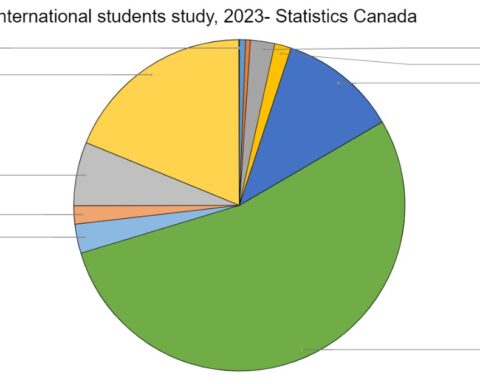Canada should make “employability” a key pillar of its foreign student recruitment drive if it wants to remain a top destination for higher education, says an expert on international graduates’ career outcomes in Asia.
Put the focus on employability, both for students that remain in Canada, the majority of whom are from South Asia, and those who return home, said Louise Nicol, director of the Asia Careers Group.
“With robust data on international graduate outcomes, Canada would be the first nation to put employability at the heart of their National Inbound International Student Recruitment campaign and lead the pack in terms of evidencing the return on investment of a Canadian degree,” she said.
This will differentiate and maintain Canada’s growth in the international higher education sector during and following the global pandemic, said Nicol, referring to a recent article she authored on the shifting dynamics of foreign students in University World News.
Immigration, Refugees and Citizenship Canada amended travel restrictions to allow international students to enter the country last month, provided the institution they are studying at has a CVOID-19 readiness plan approved by their local provincial or territorial government.
There are currently over 600 Designated Learning Institutions (DLIs) in Canada that have reopened to international students, with the next update on the approved list expected this week.
Canada and international education
The Asia Pacific Foundation of Canada estimates that in recent years, international education has been Canada’s fourth-largest export sector, with international students contributing between $15 billion and $26 billion to the Canadian economy in tuition fees (which are considerably higher than domestic student fees), accommodation, and other local expenses.
In 2018, India surpassed China as the single largest source of international students in Canada. Over a 10-year period, the number of Indian students skyrocketed from roughly 5,000 in 2008-09 to 172,00 in 2018. In addition to India, several Southeast Asian countries – Indonesia, the Philippines, Thailand, and Vietnam – have been identified by Canada as very promising new “markets” for international students.
Overall, Canada’s international student population has grown six-fold over the past 20 years. In the last decade alone, it has tripled. At the same time, Statistics Canada is warning that Canada’s 147 universities (not including colleges) could lose as much as $3.4 billion this year, mostly due to the plunge in foreign students, who last year numbered 642,000.
Sustaining Canada’s advantage
Nicol said no one can fail to be impressed by Canada’s meteoric rise in the realm of international education. “But past gains are no guarantee of future success, and the shifting tides of international student mobility can rapidly change direction,” she said.
“We are beginning to see Canadian institutions under financial pressure…But the marketing machine continues to offer easier visa channels, post-study work opportunities and routes to citizenship – none of which is a sustainable advantage if other countries choose to compete. A lack of jobs due to the global recession may lessen the attractiveness of Canada in terms of post-study work and a route to immigration,” she added.
Nicol warned that with the UK, Australia and the US all making new plans to boost international student recruitment, “Canada may only have a six-month window to differentiate its offer” by making employability a key pillar in its foreign student recruitment drive.
International employability is already a key part of Canada’s foreign student recruitment strategy, said Cindy McIntyre, Assistant Director of International Relations at Universities Canada. “(But) we do not have data on the employability of international students who do not stay in Canada after graduation,” McIntyre told NCM.
Universities Canada is a national association which advocates for Canadian universities at the federal level. It has 96 members.
“A degree from a Canadian university has world-wide recognition and opens many doors for international students after graduation, whether they choose to stay and work in Canada or pursue opportunities elsewhere in the world,” said McIntyre.
“International students make excellent candidates for permanent residency, as they are usually proficient in at least one official language, have Canadian educational qualifications, and possess in-demand skills that can help address Canada’s labour market needs,” she said. “Given these advantages, it is not surprising that 53,700 international students became permanent residents of Canada in 2018.”
According to Universities Canada,
- in 2015, one-third of international graduates who graduated from a post-secondary program remained in Canada and were working six years after graduation.
- between 20 and 27 per cent of international students at all levels of education became permanent residents within 10 years of receiving their first study permit.
- in 2015, 49 per cent of international students worked while studying in Candida, though this figure is likely to be higher today. Prior to June 1, 2014, international students had to obtain a permit to work off campus, and had to study for a period of at least six months before doing so. As of June 1, 2014, these rules are no longer in place.
- in terms of earnings after graduation, the mean earnings of former international students who remained in Canada were lower than those of Canadian citizens one year after graduation; however, they rose comparatively faster over the following five years.
- by 2016, the mean earnings of former international students were $59,890 compared with $58,708 among Canadian citizens who also graduated in 2010.
A multiple-award winning journalist, Fabian Dawson is an internationally acclaimed author, filmmaker and media expert. His work over the last four decades spans the globe and he also serves as a consultant/strategic advisor to a variety of international companies. As deputy editor-in-chief of The Province, part of the Postmedia chain, Dawson led initiatives within a special publications group to provide directed content for a variety of organisations. He was named the 2019 recipient of the Bruce Hutchison Lifetime Achievement Award at Jack Webster Awards. Dawson has been invited by the governments of India, Malaysia, Taiwan, China, Hong Kong and the United States to act as a media observer/advisor on a variety of Asian-Canada issues. Dawson, now operates FD Media, which specializes in harnessing editorial assets to revenue generating opportunities.





